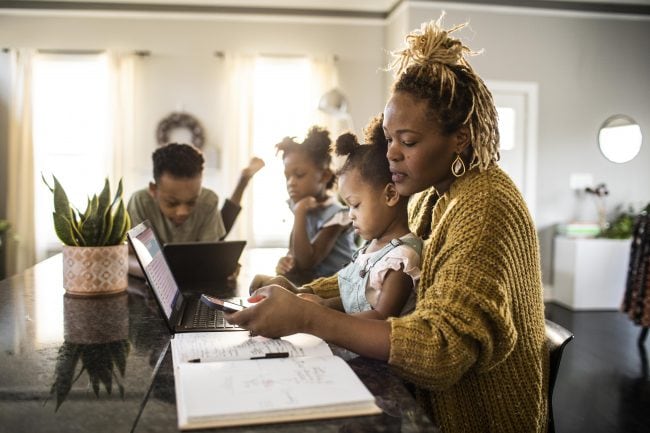
Businesses should seriously consider allowing female workers the flexibility to structure their work arrangements around family demands.
As we know, the brunt of childcare is borne by women.
After two years of COVID-19 lockdowns, Australian workers are fed up with the rigid systems that deny them flexibility. As the last of the restrictions are lifted and workers return to the workplace, is the time ripe for businesses to think about how they could accommodate workers with family responsibilities?
Workers want more flexibility in the workplace. Having this will help them juggle their outside duties and – as they did during the pandemic lockdowns – schedule their work when it suits them.
Working from home
Since early 2020 close to 13 million Australians found themselves at various times (depending on which state you live in) working from home as a result of government-imposed lockdowns as we sought to contain the spread of COVID-19.
Many workers – particularly women – found themselves juggling work with caring for home-schooling children. But they had to ask their employers to give them the flexibility in their working arrangements to do so.
The Workplace Gender Equality Agency (WGEA) found that during the pandemic, the cultural assumption that mothers should perform the caring work for children persisted.
Research reveals what workers asked for – and got
Associate Professor Dominique Allen and Ms Adriana Orifici from Monash Business School’s Department of Business Law and Taxation conducted research on Australian workers during the pandemic that reveals what they asked for in terms of flexible working arrangements to accommodate family responsibilities.
The findings have just been published in the UNSW Law Journal Forum.
“We wanted to know what people needed during this time, how employers responded to their request for flexibility, and what, if any, arrangements employers put in place,” said A/Prof Allen.
“For some workers, not having to commute to work or drop off and collect children from school meant they were able to balance work and family responsibilities. Others required temporary changes to their working arrangements, such as an earlier start or finish time.”
A/Prof Allen says that as a result of their experience with using flexible working arrangements during the pandemic, an increasing number of businesses are now more willing to embrace them in the future.
“Recent data from WGEA reveals that four out of five employers have a formal policy for flexible working arrangements and 65 per cent said that both men and women are more likely to be approved to use these arrangements in the future,” she says.

Many women juggling work with caring for home schooling children asked their employers to give them flexibility in their working arrangements.
Women want flexibility that fits with family responsibilities
The researchers’ survey was aimed at workers with family responsibilities who were required to care for or home school children during the 2020 lockdowns.
The vast majority of survey respondents – 84 per cent – were women.
“Most survey participants reported a favourable experience when making a request, using words like ‘positive’ or ‘supportive’ to describe their employer’s response, which suggests that they are likely to make such requests in the future,” A/Prof Allen says.
83 per cent of respondents had a child who required home schooling and 73 per cent of respondents had primary responsibility for home schooling. The children ranged from 3 to 17 years. Most were aged between 5 and 11.
As one of the women surveyed explained: “I would like to be able to work from home at least twice a week to balance time spent travelling between work and school drop off.”
Now, as the pandemic subsides, top of the list is flexible working arrangements.
“Our research shows that workers want the autonomy to complete their work at a time that fits in with their family responsibilities,” said A/Prof Allen.
Businesses need to consider flexible working arrangements
What’s significant for business is that Australia’s historically low unemployment rate means there is now competition for talent.
And that talent is demanding more flexibility because they know they can deliver even when working from home. In most cases – pre-pandemic – this would not have even been considered by many employers.
The researchers found that the majority of employees who requested flexible working arrangements in 2020 had their requests granted.
“Most employees who didn’t make requests didn’t need to because their jobs were already flexible,” A/Prof Allen says.
A substantial proportion of those surveyed – 87 per cent – said that the changes they negotiated during the pandemic meant that they could balance their work and caring responsibilities during the lockdown.
Access to leave entitlements
The most common arrangement employers offered was access to leave entitlements, whether that was annual leave, sick leave, carer’s leave or special ‘pandemic’ leave.
“But we found that employees don’t want to take leave,” Ms Orifici says.
“They want the flexibility to manage their time and fit their work around the other responsibilities they had to juggle during the lockdown.”
Recounting her experience, one of the female participants said: “Work was very understanding but it was difficult being in a team where only some people had small children. It was hard for people not wrangling schooling and managing a toddler to grasp how many contradictory needs were (not) being met.”
Flexible work hours are key
The most common type of changes workers sought was around the hours of work.
“Workers with caring responsibilities wanted to alter their start and finish times, temporarily reduce their working hours so they could home school or they wanted flexibility around when they did the work, like working at night or on the weekend to make up hours,” A/Prof Allen says.
This is significant for businesses that may need to be creative and consider a variety of flexible working arrangements so that employees with family or caring responsibilities can manage these competing demands beyond lockdowns and COVID-19.
“There is a misconception that working from home equals flexibility,” Ms Orifici says.
“But people working from home might still be tied to rigid schedules.”
While the past two years have been a difficult situation for employers and workers alike, there is now a real opportunity for a total overhaul of working conditions for women.


